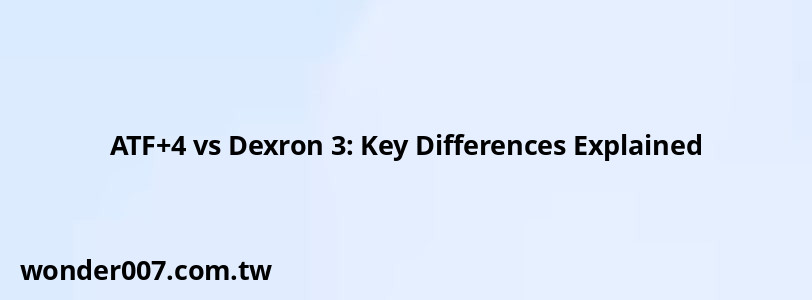ATF+4 vs Dexron 3: Key Differences Explained

ATF+4 and Dexron 3 are both automatic transmission fluids, but they have significant differences in their formulation, compatibility, and performance characteristics.
Composition and Formulation
ATF+4 is a fully synthetic transmission fluid, while Dexron 3 is a conventional mineral oil-based fluid. This fundamental difference in composition affects their performance and longevity.
- ATF+4 contains Group 3 base oil with advanced additive packages
- Dexron 3 uses Group 2 base oil with standard additives
Vehicle Compatibility
The two fluids are designed for different vehicle makes and models:
- ATF+4 is specifically formulated for Chrysler, Ram, Jeep, and Dodge vehicles
- Dexron 3 is compatible with older General Motors and Ford transmissions
It's crucial to use the correct fluid specified by your vehicle manufacturer to ensure optimal performance and prevent damage.
Performance Characteristics
ATF+4 generally offers superior performance compared to Dexron 3:
- Better wear protection
- Improved resistance to oxidation and sludge buildup
- Enhanced friction durability
- Longer fluid life
Dexron 3, while still effective for its intended applications, may not provide the same level of protection in modern, high-performance transmissions.
Backwards Compatibility
ATF+4 is backwards compatible with older Chrysler fluids like ATF+, ATF+2, and ATF+3. However, Dexron 3 is not forward compatible with systems requiring ATF+4.
Mixing Fluids
It's generally not recommended to mix ATF+4 and Dexron 3. While they may not cause immediate harm if mixed in small quantities, prolonged use of the wrong fluid can lead to transmission issues.
FAQs About ATF+4 and Dexron 3
- Can I use ATF+4 instead of Dexron 3?
While ATF+4 is generally a higher-quality fluid, it's not recommended to use it in place of Dexron 3 unless specified by your vehicle manufacturer. - How often should I change these fluids?
ATF+4 typically has a longer service life, often lasting up to 100,000 miles. Dexron 3 may require more frequent changes, around every 30,000-50,000 miles. - What happens if I use the wrong fluid?
Using the incorrect fluid can lead to poor shifting performance, increased wear, and potential transmission damage over time.
In conclusion, while both ATF+4 and Dexron 3 serve as automatic transmission fluids, they are distinct products designed for different vehicle types and transmission systems. Always consult your vehicle's manual and use the recommended fluid to ensure optimal performance and longevity of your transmission.
Related Posts
-
P Warning Light: Dashboard Symbol Explained
29-01-2025 • 167 views -
Takeuchi TB240 Warning Symbols Explained
26-01-2025 • 336 views -
International Truck Dashboard Symbols Explained
26-01-2025 • 147 views -
Toyota Yaris: Timing Belt or Chain Explained
29-01-2025 • 136 views -
Hyundai Santa Fe Rear Differential Replacement Costs Explained
28-01-2025 • 159 views
Latest Posts
-
2015 Chevy Traverse AC Recharge Port Location
01-02-2025 • 327 views -
How To Turn Off Paddle Shifters Mercedes
01-02-2025 • 289 views -
Power Steering Fluid Leak On Passenger Side
01-02-2025 • 370 views -
Rear Brake Caliper Piston Won't Compress
01-02-2025 • 273 views -
Are O2 Sensors Covered Under Warranty
01-02-2025 • 300 views
Popular Posts
-
Power Steering and ABS Light On: Causes and Solutions
27-01-2025 • 571 views -
2015 VW Passat Oil Consumption Issues Explained
26-01-2025 • 533 views -
EPC Warning Light: What It Means for Your Vehicle
27-01-2025 • 550 views -
EPC Light: Understanding Causes and Solutions
26-01-2025 • 968 views -
V12 Engine Costs: What You Need to Know
26-01-2025 • 551 views
